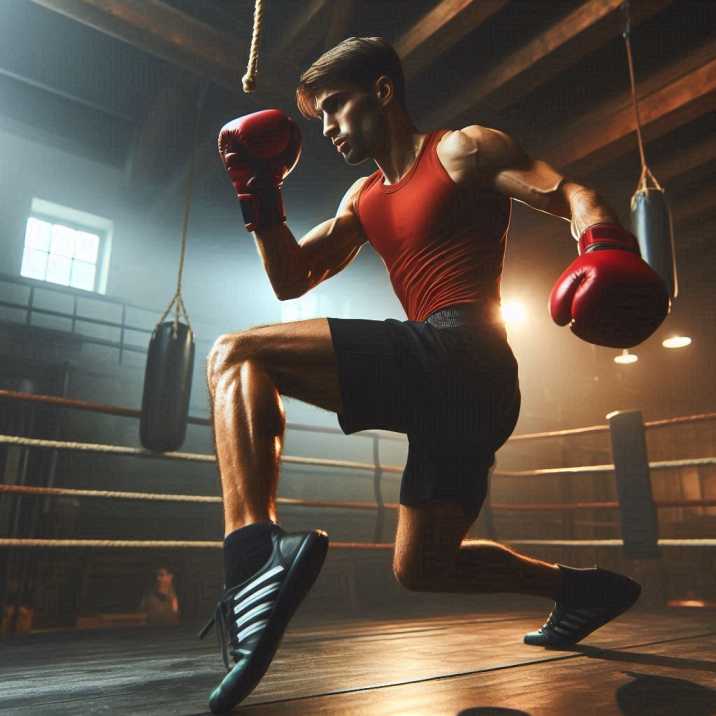Introduction:
Table of Contents
Boxing is a sport that demands a combination of skill, strategy, and athleticism. From the precise execution of punches to the graceful movement across the ring, mastering the art of boxing requires dedication and practice. In this comprehensive guide, we’ll demystify some of the most fundamental techniques in boxing: jabs, hooks, uppercuts, and footwork. Whether you’re a novice looking to learn the basics or a seasoned boxer aiming to refine your skills, this article will provide valuable insights to help you succeed in the ring.

Understanding Boxing Techniques:
1. Jabs:
What is a Jab?
A jab is a fundamental punch in boxing, executed with the lead hand, aiming for the opponent’s face or body. It serves multiple purposes, including maintaining distance, disrupting the opponent’s rhythm, and setting up combinations.
How to Execute a Jab:
Stance: Start in a balanced stance, with your lead foot positioned slightly forward and your rear foot trailing. This stance provides stability and allows for fluid movement.
Extension: Extend your lead arm straight out towards the target, keeping your elbow slightly bent to prevent hyperextension. The punch should be delivered with a snapping motion, utilizing the front two knuckles of your fist for maximum impact.
Recovery: After delivering the jab, swiftly retract your arm back to the guard position to defend against counterattacks. Maintaining a tight guard is essential for protecting yourself while setting up your next move.
2. Hooks:
What is a Hook?
A hook is a powerful punch thrown in a circular motion, targeting the opponent’s head or body from the side. It’s often used at close range to generate significant force and inflict damage.
How to Throw a Hook:
Rotation: Initiate the hook by rotating your torso and pivoting on your lead foot, transferring the force from your lower body to your upper body. This rotational movement generates power and momentum behind the punch.
Arm Position: Keep your elbow bent at a 90-degree angle, positioning your forearm parallel to the ground. Strike with the knuckles of your fist, aiming to land with the side or front of your fist for optimal impact.
Guard: Maintain a solid guard with your opposite hand to protect your face while throwing the hook. It’s crucial to keep your other hand up to defend against potential counterattacks.
3. Uppercuts:
What is an Uppercut?
An uppercut is a punch that travels upward, targeting the opponent’s chin or body from close range. It’s a devastating punch that can penetrate the opponent’s defense and deliver significant damage.
Executing an Uppercut:
Close Range: Uppercuts are most effective when thrown at close range, allowing you to generate power from your lower body and transfer it into the punch. Position yourself within striking distance before initiating the uppercut.
Body Mechanics: Bend your knees slightly and drive upward with your hips to generate power for the uppercut. The force should originate from your legs and core, with your arm serving as a conduit for delivering the punch.
Targeting: Aim to strike with the knuckles of your fist, driving upward towards the opponent’s chin or body. Focus on accuracy and timing to ensure that the uppercut lands with maximum force and effectiveness.
4. Footwork:
Importance of Footwork:
Footwork is the foundation of boxing, allowing you to move effectively around the ring, evade your opponent’s attacks, and create opportunities for offense. Good footwork enables you to maintain balance, control, and distance from your opponent, giving you a tactical advantage in the fight.
Essential Footwork Techniques:
Maintaining Balance: Keep your weight evenly distributed between both feet, with a slight bend in your knees to absorb movement and maintain stability. This balanced stance allows you to move in any direction quickly and efficiently.
Pivoting: Mastering the pivot is essential for changing direction and creating angles of attack. Pivot on the balls of your feet, allowing your body to rotate smoothly without losing balance. Pivoting enables you to maneuver around your opponent and set up powerful punches from different angles.
Angles: Lateral movement is key to creating angles of attack and disrupting your opponent’s defense. Use side-to-side movement to confuse your opponent, making it difficult for them to anticipate your next move. Angles allow you to control the pace of the fight and dictate the flow of action in the ring.

Table summarizing key information about boxing techniques:
| Technique | Description | Execution |
|---|---|---|
| Jabs | Quick, straight punch with the lead hand. | Begin in a balanced stance. |
| Extend lead arm straight out. | ||
| Retract arm quickly to guard position. | ||
| Hooks | Powerful punch in a semi-circular motion targeting head or body. | Rotate torso and pivot on lead foot. |
| Keep elbow bent at a 90-degree angle. | ||
| Protect face with opposite hand. | ||
| Uppercuts | Punch that travels upwards, typically targeting chin or body. | Position for close range. |
| Bend knees and drive upward with hips. | ||
| Strike with knuckles driving upwards. | ||
| Footwork | Crucial for movement, evasion, and creating angles of attack. | Maintain balanced stance with even weight distribution. |
| Pivot smoothly on balls of feet for directional changes. | ||
| Utilize lateral movement to confuse opponent. |
This table provides a concise overview of the key aspects of each boxing technique, including their descriptions and execution guidelines.
Conclusion:
Mastering boxing techniques such as jabs, hooks, uppercuts, and footwork is essential for success in the ring. By understanding the fundamentals and practicing diligently, boxers can improve their skills, enhance their performance, and achieve their goals. Whether you’re a beginner or an experienced fighter, this guide serves as a valuable resource to unlock the secrets of boxing mastery. So, step into the ring with confidence, hone your skills, and let your prowess as a boxer shine.
Frequently Asked Questions (FAQs):
- Q: What is the most important boxing technique? A: While all techniques are essential, mastering the jab is particularly crucial as it sets up other punches and helps maintain distance.
- Q: How can I improve my footwork in boxing? A: Practice drills such as shadowboxing, ladder drills, and agility exercises to improve footwork and movement in the ring.
- Q: Are boxing techniques effective for self-defense? A: Yes, boxing techniques can be highly effective for self-defense, providing skills to protect oneself and deter potential attackers.
- Q: Can anyone learn boxing techniques, regardless of age or fitness level? A: Yes, boxing can be adapted to suit individuals of all ages and fitness levels, with training programs tailored accordingly.
- Q: How important is it to train with a qualified boxing coach? A: Training with a knowledgeable coach can greatly accelerate skill development, provide valuable feedback, and ensure safe and effective training practices.


